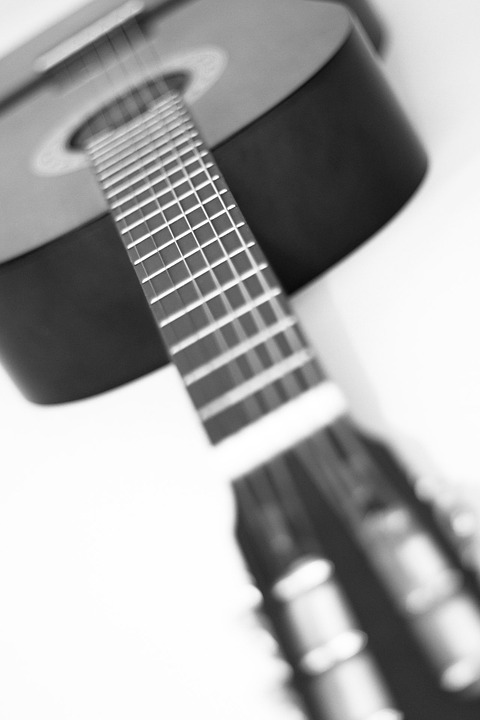Best Guitar Tips For Beginners

The guitar is an amazing instrument and learning to play it is a very rewarding experience. If you want to learn to play the guitar, these guitar tips will help you get started.
Guitar Tips For Beginners To Learn To Play Guitar
Learning to play guitar is fun, but unfortunately, a lot of beginners give up before they learn to play anything. Just like with any other instrument, there is a learning curve. Playing the guitar requires dedication and a lot of practice.
Here are some guitar tips to help you get started.
How To Hold Your Guitar

Not holding your guitar properly is a common mistake among beginners. You might hold the neck too tightly or tilt the guitar upwards to see your fingers moving up and down the neck of your guitar.
Adopting good posture is important. It will help you stay comfortable while you play, and you will be able to play for hours without getting tired.
Use a footstool to correct your posture. Elevating one leg and using it to support your guitar will help you keep the instrument upright while you play it. Make a conscious effort not to tilt the guitar towards you. You shouldn’t be able to see what your fingers are doing on the neck of the instrument.
Holding the neck of the guitar too tightly is another common mistake. Keep your grip loose so you can easily move your fingers.
Tune Your Guitar

Invest in an electronic clip-on tuner if you are serious about learning to play the guitar. Tuning your guitar should be the first thing you do when you practice.
Tuning a guitar by ear is difficult, especially if you are new to playing music. Many beginners don’t know how to tune their guitar and give up because nothing they play sounds good.
Electronic clip-on tuners are inexpensive. These devices use an indicator light to let you know if a string is in tune or not. Playing and hearing the correct pitch for each note will help you progress. Try tuning your guitar by ear once you become familiar with the pitch of the notes.
Start With The Basic Chords

Think of guitar chords as the building blocks you will put together to play music. You need to practice guitar chords until playing these chords becomes second nature.
Practicing with guitar chords will help you build strength and flexibility in your fingers, which is essential if you want to become a guitar player.
You can either print out some diagrams that show all the main chords you need to know or use apps to learn guitar chords. Start with some easy chords that require fewer points of contacts on the neck of the guitar.
The basic major guitar chords include C, A, G, E, D, F. Once you know these, you can learn minor chords, including A, D, and E minor. You will encounter these nine chords in pretty much every song you play.
Practice With Scales

A scale is a progression on the neck of the guitar. It is a pattern that takes you from one note to another.
Practicing with scales is important because these patterns are the melodies that you will encounter in most of the songs you learn to play. Scales are a great introduction to music theory and will help you become more comfortable with your instrument.
These melodies will have a different tonality depending on where you start playing the scale on the neck of your guitar. Learning a scale can seem complicated at first, but the possibilities are endless once you can play a pattern.
The major scale is a good place to start. You can start playing this scale on any of the major notes and will recognize this scale in a lot of the songs you learn.
You should also learn the natural minor scale. You can start this scale on any of the minor notes. This scale is used in many different musical genres.
You can go further by learning the minor pentatonic scale and the blues scale. These are two other important melodies you will recognize in a lot of songs.
Practicing with scales helps you start playing melodies and will help you understand how songs are built.
Scales will also provide you with the knowledge you need to improvise when playing guitar.
Try Different Strumming Patterns

A lot of beginners are unsure of what to do with their strumming hand. Practicing strumming patterns is important since it will help you create a rhythm when you start playing songs.
You should practice strumming without worrying about playing any chords. Mastering this move is important. Keep your wrist loose and experiment with different speeds. The trick is always to keep your strumming hand moving.
Learning to count beats will help you find the right strumming pattern for a song. You can learn to count beats by paying attention to the tempo of your favorite songs.
Playing with a metronome will help you keep track of the tempo, but you can tap with your foot to count beats.
Most songs have a 4/4 beat. Focus on songs that use this simple tempo when you are first learning.
Every song has a unique strumming pattern, but you will typically strum the lower strings on the first and third beat and the higher strings on the second and fourth beat.
Get started with downstrokes. There are simple songs you can play entirely with downstrokes. You can practice keeping up with the beat of a song by playing a downstroke on every beat. Remember not to hit every string with each stroke.
Once you are more comfortable with strumming, add some upstrokes to your strumming patterns. You would typically play a downstroke on every beat of a melody and add an upstroke between beats.
Note that you don’t need to add an upstroke in between every beat of a song. You can also learn more complex songs that mix the traditional 4/4 pattern and mix it with other patterns, for instance by removing beats.
Practice Makes Perfect
The most important guitar tips are to practice as much as possible and not to give up even if you aren’t getting the results you were hoping for. Mastering an instrument takes years so don’t expect to be able to play your favorite songs right away.
Your first guitar practice sessions might not be fun since you will have to focus on learning chords. This isn’t something you can skip since you need to develop muscle memory to play this instrument.
Things will get more interesting once you start exploring scales, strumming patterns, and start to learn simple songs.
Practice on a regular basis and spend time going over what you already know. You should also take some time to just play random melodies, experiment with your guitar, and become more familiar with it. This is an important part of the learning process, and this is how you will find a unique sound.
This is why you should make learning scales a priority. Scales will become building blocks you can use to find new melodies. You can plan them in different tonalities, combine them, and work them into the songs you are learning to create something unique.
Find The Right Resources

There are plenty of resources and guitar tips you can use to learn to play the guitar. Taking lessons with an instructor is a great way to learn since you will get some feedback on what you are doing.
If you have a friend who knows how to play, ask them to watch your posture and to teach you the basic chords. You will progress faster and learning guitar will be more fun if you have a friend who can show you a few things and maybe play along with you.
Videos and online tutorials are another great way to learn guitar. Watching someone play a song will help you memorize strumming patterns, and it will be easier to follow the rhythm and progression of a song once you see someone play it.
Using guitar tabs is a more challenging way to learn since tabs won’t show you the strumming pattern or rhythm you need to follow to learn a song. Tabs are a useful learning tool since they will show you the chords you need to play.
However, you will need to listen to the song you want to learn to figure out the strumming patterns and tempo. It might be best to learn until you have more experience before using tabs.
It is important to select learning resources that are adapted to your level. If you feel that you are not getting the results you want, look for a different way to learn.
Learning to play the guitar is a fun and rewarding experience, but it is important to have realistic expectations. You will need to spend some time learning the basic chords, scales, and strumming patterns before you can have fun with your new instrument. Don’t give up and your hard work will pay off.

